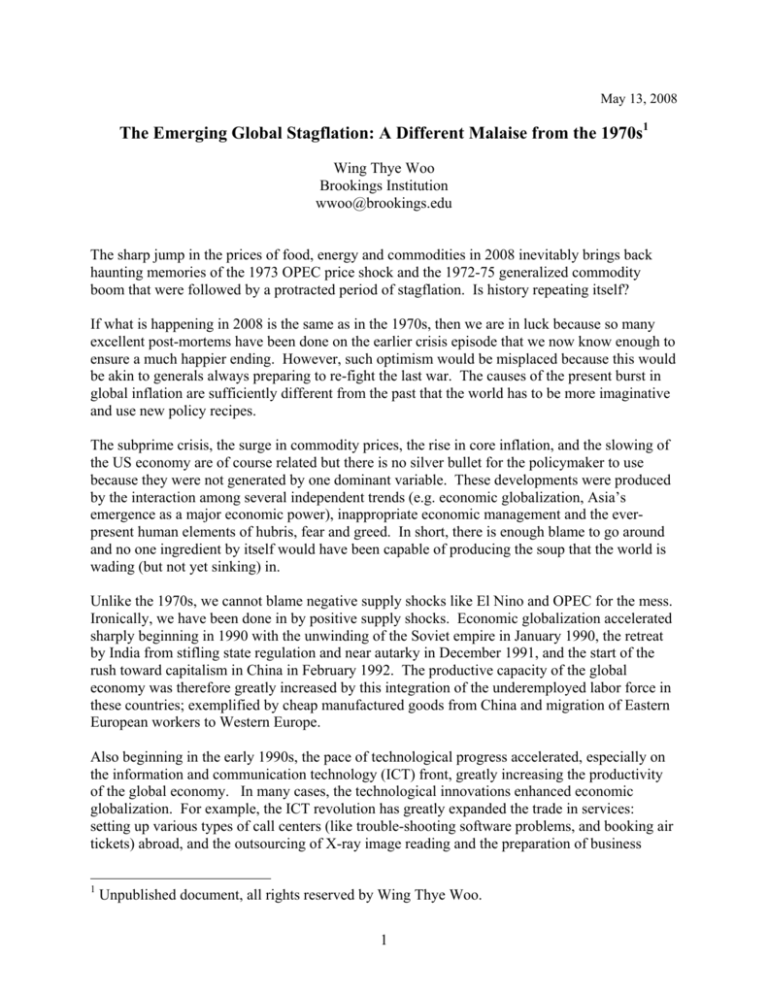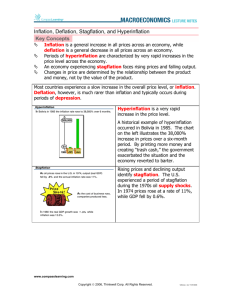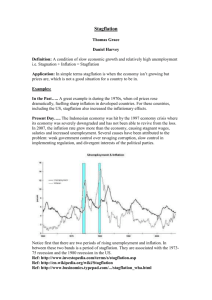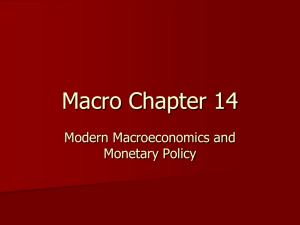
May 13, 2008
The Emerging Global Stagflation: A Different Malaise from the 1970s1
Wing Thye Woo
Brookings Institution
wwoo@brookings.edu
The sharp jump in the prices of food, energy and commodities in 2008 inevitably brings back
haunting memories of the 1973 OPEC price shock and the 1972-75 generalized commodity
boom that were followed by a protracted period of stagflation. Is history repeating itself?
If what is happening in 2008 is the same as in the 1970s, then we are in luck because so many
excellent post-mortems have been done on the earlier crisis episode that we now know enough to
ensure a much happier ending. However, such optimism would be misplaced because this would
be akin to generals always preparing to re-fight the last war. The causes of the present burst in
global inflation are sufficiently different from the past that the world has to be more imaginative
and use new policy recipes.
The subprime crisis, the surge in commodity prices, the rise in core inflation, and the slowing of
the US economy are of course related but there is no silver bullet for the policymaker to use
because they were not generated by one dominant variable. These developments were produced
by the interaction among several independent trends (e.g. economic globalization, Asia’s
emergence as a major economic power), inappropriate economic management and the everpresent human elements of hubris, fear and greed. In short, there is enough blame to go around
and no one ingredient by itself would have been capable of producing the soup that the world is
wading (but not yet sinking) in.
Unlike the 1970s, we cannot blame negative supply shocks like El Nino and OPEC for the mess.
Ironically, we have been done in by positive supply shocks. Economic globalization accelerated
sharply beginning in 1990 with the unwinding of the Soviet empire in January 1990, the retreat
by India from stifling state regulation and near autarky in December 1991, and the start of the
rush toward capitalism in China in February 1992. The productive capacity of the global
economy was therefore greatly increased by this integration of the underemployed labor force in
these countries; exemplified by cheap manufactured goods from China and migration of Eastern
European workers to Western Europe.
Also beginning in the early 1990s, the pace of technological progress accelerated, especially on
the information and communication technology (ICT) front, greatly increasing the productivity
of the global economy. In many cases, the technological innovations enhanced economic
globalization. For example, the ICT revolution has greatly expanded the trade in services:
setting up various types of call centers (like trouble-shooting software problems, and booking air
tickets) abroad, and the outsourcing of X-ray image reading and the preparation of business
1
Unpublished document, all rights reserved by Wing Thye Woo.
1
accounts. There were also substantial technological breakthroughs in transportation,
manufacturing processes, and medical procedures that lowered costs in these sectors.
The New Thinking on Monetary Policy and Financial Supervision
Optimism was the natural outcome of these positive supply-side developments, but it was
allowed to morph into irrational exuberance by a monetary policy that was based on the new fad
of inflation-targeting. Despite the low US interest rates, credit did not seem loose when
examined from the narrow prism of CPI inflation because the excess credit was pushing up the
prices of items not included in the CPI, notably, financial assets and real estate.
When the dot-com bubble inevitably exhausted itself in March 2000, the Nasdaq Composite
Index fell from nearly 5,000 to less than 2000 in 2001, the concern for potentially contractionary
consequences led to a further lowering of interest rates. The froth from the NASDAQ market
was thence transferred and added on to those in the other asset markets.
To be fair, the complacency of the Federal Reserve (Fed) toward asset bubbles and the lone
obsession with the movements of consumer prices were widely shared by other major central
banks and by the economics profession. Over the years, the central banking community and the
economics discipline had become increasingly infatuated with the self-correcting powers of
enlightened self-interest as evidenced by the ever-growing academic paeans to the efficiency of
the financial markets. The fact that some of the leading exponents of financial engineering
(based on the assumption of financial market efficiency) were awarded the Nobel Prize lent
confidence to the Panglossian view of financial markets.
The unintended but inexorable consequence of this faith in the collective judgment of the
millions of investors, who (thanks to the internet) are constantly incorporating the latest news
into their assessments of asset prices and acting on them, was that prudential supervision by the
financial authorities lagged behind the development of new financial instruments. The fact that
the financial industry could afford effective lobbying in Congress certainly helped to enshrine
the view that self-policing was adequate, a view that is particularly soothing when it is pointed
out that more regulation could result in loss of competitiveness to foreign stock markets. Hedge
funds proliferated, the securitization of mortgages and derivatives of various sorts sprung up, and
the subprime mortgage market boomed.
Greed, Hubris and Fear
The lapse of stock market sentiments into occasional bouts of exuberance and melancholia is
such a well-documented historical phenomenon that Paul Volcker had described this unstable
trait as “built into the human genome.” We would add, in the same vein, that greed is built into
the institutional genome of the financial markets. When mortgage lenders could easily unload
their loans in the secondary market, they faced reduced incentive to conduct thorough
background checks and prudent financial evaluations of their clients. The gatekeeper function of
the bond-rating agencies was compromised by the incentive to boost earnings by advising issuers
2
on how to bundle loans to attain the maximum rating that was just barely consistent with the
wording of the rating guidelines. The upshot, as Ben Bernanke concluded, was that “far too
much of the lending in recent years was neither responsible nor prudent.”
The Fed’s decision to adopt a narrow definition of price stability to guide credit policy, and the
regulators’ belief in the self-corrective powers of financial markets reflect another evergreen
human element, hubris. When official hubris meets private greed in a setting characterized by
occasional sizable mood swings, the outcome is an accident in the making.
The first crash occurred in 1998 when the Fed organized a bailout of the Long-Term Capital
Management (LTCM) after it suffered major losses from the financial panic that ensued
following the default by the Russian government on its bonds. Clearly, this action by the Federal
Reserve reflected its opinion that LTCM was too big to fail, a failure that could cause a 1929style chain reaction in the financial sector culminating in severe production dislocation in the real
sector. This was one risk that any Fed Board would want to minimize, and the incentive to
preserve reputation in a setting that is not profit-maximizing would bias any assessment of this
risk towards extraneous pre-emptive intervention.
The cost of preventing this meltdown risk, however, was the creation of the moral hazard that the
biggest financial houses might thence become even more reckless in their speculations because
of their faith in being rescued in some form by the government should their investments go awry.
Another operational principle of the Federal Reserve in meeting its mandated role of
“macroeconomic stabilizer” has now become transparent (in addition to its monetary policy of
targeting the CPI inflation rate): the Fed would also intervene to keep major financial companies
from collapsing. The commitment to this operational principle was confirmed on March 14,
2008 when the Federal Reserve responded to the subprime mortgage crisis by extending its role
as the lender of last resort beyond the commercial banks to include investment banks as well.
The Broken System
While the Fed’s judgment that an abrupt collapse of Bear Stearns would have caused large-scale
financial panic and failure, and an economic destruction on the scale of the 1997-98 Asian
Financial Crisis is likely to be correct, one cannot help wondering if this truly humongous
subprime bubble was not partly encouraged by the earlier risk-averse policy reactions to the
LTCM crisis and to the bursting of the dot-com bubble. The fact that the stock prices of the
other investment banks leaped up considerably in the wake of the Bear Stearns rescue could only
exacerbate moral hazard by solidifying investors’ belief that the “too big to fail” mentality has
indeed been entrenched in the Fed, just as it had been entrenched earlier in many central banks in
East Asia (a condition oft-mislabeled “crony capitalism”).
The contrast drawn by the astute financial market analyst, Henry Kaufman, between the
increasing opacity of the actions of the financial institutions and the growing transparency of the
intentions of the financial authorities captures, arguably, the most fundamental problem with the
US financial system and its fragmented regulatory bodies. The fast proliferation of complicated
financial derivatives and of hedge funds means that the amount and distribution of risk in the
3
financial system is not sufficiently monitored by the regulatory agencies. The now transparent
operational principle of saving the largest financial houses in crisis while exempting them from
the regulations that apply to commercial banks is folly. The US international system (in fact, the
global financial system) is an accident waiting to happen because of the outmoded prudential
supervisory system in place.
It is instructive to point out that the economic fallout from a large financial collapse is not
necessarily marked by falling goods prices as in Japan after its stock market meltdown in 1992, it
could be marked by rising goods prices instead. The latter occurs when the central bank
administers a large liquidity injection into the economy to reduce bank failures, housing
foreclosures and consumer loan default. The usual outcome is a plunging exchange rate, an
inflationary spurt that greatly reduces the real value of the bad loans, and a moderate drop in
output. The liquidity injection is in effect the use of the inflation tax to pay off the bad loans;
and its likely side effect is stagflation.
Given the excessive credit creation in the last fifteen years, the aggressive liquidity injection by
the Fed in reaction to the subprime crisis, and the high commodity prices that will ensure higher
consumer prices for some time, we think that a stagflation awaits the next president of the United
States. The best response to this malaise, we will argue, will require not only new initiatives at
home but also abroad.
Changing External Circumstances
One could make the plausible case that the global inflation of the 1970s was the result of US
monetary expansion to build the Great Society and to fight the Vietnam War. The resulting US
balance of payments deficits distributed this flood of liquidity around the globe, igniting the
global inflation. Stagflation came because the OPEC price increases of 1973 and 1979 were
large negative supply-side shocks.
It would be incorrect, however, to claim that the excessive credit expansion in the US over the
last decade and a half bears primary responsibility for the present global inflation. First, the
Bretton Woods exchange rate system is gone, and so there is no easy link between US monetary
expansion and monetary expansion elsewhere. Second, almost all of the countries that continued
to peg their currencies to the US$ (most of the time) have devised ways to achieve monetary
independence. The recent housing bubbles in many countries and the commodity inflation have
their roots in different independent causes in these countries.
Take the case of China for example. It is the claim of many China-watchers that the high money
growth rates since 2003 were caused by the mounting balance of payments surpluses generated
by pegging the Renminbi (RMB) at an undervalued level.2 This simple-minded accounting
approach is wrong because such a direct link is institutionally impossible. All Chinese banks are
state-controlled and they face individually-set credit quotas, and since all their managers are
career-maximizing rather than profit-maximizing, credit growth could not have stayed high
2
We note that one could also say instead that the overly expansionary US monetary policy had rendered
the pegged level to be undervalued.
4
without continual large upward adjustments of the credit quotas by the People's Bank of China
(PBC).
The reason for the large upward adjustments of the credit quotas (until December 2007) is the
exercise of political patronage by Hu Jintao, who became the head of the Chinese Communist
Party in November 2002, to consolidate his position. The flood of investment loans was
politically useful as long as CPI inflation was quiescent, which was the case until production
bottlenecks started appearing in the last half of 2007. (A part of the newly-created liquidity
flowed into the stock market and the housing market, creating record booms in 2006 and 2007.)
With the end of the 17th Party Congress in November 2007, the Chinese government has been
taking serious steps to slow the growth of aggregate demand (e.g. by raising interest rates and
bank reserve requirements, and appreciating the RMB), and the first prominent casualty is share
prices.
However, the Chinese fight against inflation has been made harder by two negative supply side
shocks that began in summer 2007. The first has domestic origins: the summer flood and the
winter storm reduced grain and vegetable production, and the blue-ear disease decimated the pig
population. The second shock supply shock is external in origin: the swingeing rise in the prices
of industrial commodities like crude oil, iron ore, and palm oil. If we now also factor in the
growing recession in the United States, China is also headed for a stagflation, albeit of a milder
version than the US.
The commodity inflation of 2007 and 2008 is the product of the accelerated pace of
industrialization in Asia and Latin America in the 2000s. It cannot be attributed either to the
actions of commodity cartels or to just China's growing imports of commodities. The
commodity inflation is a supply-side shock to the importers of primary commodities e.g. US and
Japan. As commodities are inputs, high CPI inflation will continue for a while because it takes
time for the higher input prices to pass entirely through the production chain to be fully
incorporated into consumer prices.
The U.S. Policy Agenda Going Forward
The following six items should be on the US policy agenda to address the causes of the emerging
global stagflation.
First, given both the destructive potential of a financial crisis and the frequent use of public
money to save failed financial houses, the financial system has to be better regulated to prevent
financial failures, whose frequent byproduct is stagflation. The U.S. should consolidate the
regulation of the entire financial system within a new financial market regulator. To use Henry
Kaufman's terms, instead of passively regarding the biggest financial institutions to be "too big to
fail", this new market regulator should actively improve the prudential supervisory techniques to
render the biggest financial institutions to be "too good to fail." The U.S. must jettison the
practice where the profits of the biggest financial houses are privatized but their losses socialized.
5
Second, given the growing and tightening of economic linkages among countries, and the real
possibility of a race to the bottom in financial regulation, the next president should quickly
engage the European Union (EU) and Japan in raising and harmonizing the regulatory standards
in their financial markets.
Third, the present US financial agencies are geared toward preventing financial contagion within
US borders, and are grossly inadequate for limiting international contagion. The IMF has at best
a mediocre record in handling international contagion, and its present governance structure does
not give it the legitimacy to coordinate the concerns of the global community on this matter. The
next US President should call for an international conference (possibly, under UN auspices) to
design an international financial architecture that is appropriate for present circumstances.
Fourth, the Federal Reserve should become a more specialized agency. It should focus on its
monetary policy role and give up its regulatory role. The Fed must refine its inflation target to
include asset price inflation. It was famously said by a former Fed chairman that a competent
central banker is someone who takes away the punch bowl just as the party gets going. Right
now, the Fed is ascertaining the mood swing in the party by staring at only one specific corner of
the room, which is clearly not the optimum way to identify the tipping point of the mood within
the room.
Fifth, in the short-run when output is limited by existing production capacity, the higher prices of
commodities mean that the net real national income of a commodity-importing country, e.g. US
and EU, has to fall via lower wages and reduced profits until capital accumulation and
technological improvements have raised income enough to cover the additional payments to the
commodity exporters. In this transition period, its is important to suspend any automatic
indexing of wages to inflation in order to avoid a further squeeze on profits which would then
slow down capital accumulation and prolong the transition phase (and keep unemployment
higher). During this transition phase, the government must increase its welfare budget in order
to ensure that the poor segments of society do not fall below the minimum living standard.
Sixth, Asia and Latin America will continue their convergence to the living standards of the
OECD. The expected large rise in Asian and Latin American income really means an anticipated
large increase in industrial production in these two regions, and a coming large rise in
greenhouse gases. Given the rapidly growing global worry about climate change, a global CO2
ceiling is a very likely outcome in the medium run, and such a ceiling would be a much larger
supply-side shock to the US (and the world) than the present high commodity prices, i.e. a worse
stagflation would follow the present one!3
The global climate change agenda is very important to the United States on many fronts beside
the economic one. The development of clean energy is fundamental to addressing the problem.
The next president should mobilize not only a domestic state-university-business coalition to
work for a breakthrough in alternative energy but also an international scientific coalition to
maximize the probability of an early breakthrough.
3
The “good” news for the next president is that a global CO2 ceiling would probably not materialize
within the next eight years.
6
Clearly, if the U.S. cannot achieve the international cooperation required for effective financial
supervision to alleviate the present stagflation, it is highly improbable that the U.S. can achieve
the international cooperation to prevent the worse stagflation created by climate change. The
next president had better be a good consensus builder at home and abroad.
7










